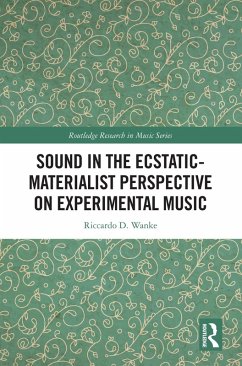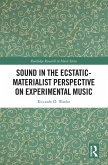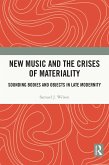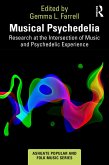Sound in the Ecstatic-Materialist Perspective on Experimental Music (eBook, PDF)
Sofort per Download lieferbar

Sound in the Ecstatic-Materialist Perspective on Experimental Music (eBook, PDF)
- Format: PDF
- Merkliste
- Auf die Merkliste
- Bewerten Bewerten
- Teilen
- Produkt teilen
- Produkterinnerung
- Produkterinnerung

Hier können Sie sich einloggen

Bitte loggen Sie sich zunächst in Ihr Kundenkonto ein oder registrieren Sie sich bei bücher.de, um das eBook-Abo tolino select nutzen zu können.
What does a one hour contemporary orchestral piece by Georg Friedrich Haas have in common with a series of glitch-noise electronic tracks by Pan Sonic? This book proposes that, despite their differences, they share a particular understanding of sound that is found across several quite distinct genres of contemporary art music: the ecstatic-materialist perspective. Sound in the ecstatic-materialist perspective is considered as a material mass or element, unfolding in time, encountered by a listener, for whom the experience of that sound exceeds the purely sonic without becoming entirely…mehr
- Geräte: PC
- mit Kopierschutz
- eBook Hilfe
![Sound in the Ecstatic-Materialist Perspective on Experimental Music (eBook, ePUB) Sound in the Ecstatic-Materialist Perspective on Experimental Music (eBook, ePUB)]() Riccardo D. WankeSound in the Ecstatic-Materialist Perspective on Experimental Music (eBook, ePUB)39,95 €
Riccardo D. WankeSound in the Ecstatic-Materialist Perspective on Experimental Music (eBook, ePUB)39,95 €![New Music and the Crises of Materiality (eBook, PDF) New Music and the Crises of Materiality (eBook, PDF)]() Samuel WilsonNew Music and the Crises of Materiality (eBook, PDF)39,95 €
Samuel WilsonNew Music and the Crises of Materiality (eBook, PDF)39,95 €![The Ashgate Research Companion to Experimental Music (eBook, PDF) The Ashgate Research Companion to Experimental Music (eBook, PDF)]() The Ashgate Research Companion to Experimental Music (eBook, PDF)47,95 €
The Ashgate Research Companion to Experimental Music (eBook, PDF)47,95 €![Blixa Bargeld and Einstürzende Neubauten: German Experimental Music (eBook, PDF) Blixa Bargeld and Einstürzende Neubauten: German Experimental Music (eBook, PDF)]() Jennifer ShryaneBlixa Bargeld and Einstürzende Neubauten: German Experimental Music (eBook, PDF)56,95 €
Jennifer ShryaneBlixa Bargeld and Einstürzende Neubauten: German Experimental Music (eBook, PDF)56,95 €![Handmade Electronic Music (eBook, PDF) Handmade Electronic Music (eBook, PDF)]() Nicolas CollinsHandmade Electronic Music (eBook, PDF)38,95 €
Nicolas CollinsHandmade Electronic Music (eBook, PDF)38,95 €![Musical Psychedelia (eBook, PDF) Musical Psychedelia (eBook, PDF)]() Musical Psychedelia (eBook, PDF)39,95 €
Musical Psychedelia (eBook, PDF)39,95 €![Acoustic Profiles (eBook, PDF) Acoustic Profiles (eBook, PDF)]() Randolph JordanAcoustic Profiles (eBook, PDF)15,95 €
Randolph JordanAcoustic Profiles (eBook, PDF)15,95 €-
-
-
Dieser Download kann aus rechtlichen Gründen nur mit Rechnungsadresse in A, B, BG, CY, CZ, D, DK, EW, E, FIN, F, GR, HR, H, IRL, I, LT, L, LR, M, NL, PL, P, R, S, SLO, SK ausgeliefert werden.
- Produktdetails
- Verlag: Taylor & Francis eBooks
- Seitenzahl: 176
- Erscheinungstermin: 9. August 2021
- Englisch
- ISBN-13: 9781000430240
- Artikelnr.: 62217746
- Verlag: Taylor & Francis eBooks
- Seitenzahl: 176
- Erscheinungstermin: 9. August 2021
- Englisch
- ISBN-13: 9781000430240
- Artikelnr.: 62217746
- Herstellerkennzeichnung Die Herstellerinformationen sind derzeit nicht verfügbar.
A multifaceted approach
Overview
Remarks and limitations
Notes
1 Sound in 20th-century music
Scelsi and the centrality of sound
Key aspects of sound in the ecstatic-materialist perspective
From music to sound
From the beginning of the century up to 1980: a plural emancipation
Spectral line
Minimalist line
Musique concrète and avant-garde lines
From the 1980s onwards: a non-linear expansion
Sonic map
Case studies: selection of pieces
Closing remarks
Notes
2 Morphology and structure of musical works
Starting points of the analysis
Sequential method
Step 1: Identification of common characteristics and morphologies
Step 2: Identification of common developments (unfolding structures)
Results
Low-level attributes
(A) An expanded spectrum
(B) Microtonal variations
(C) Systematic glissandi
(D) Rhythmic development
(E) Static masses
(F) Repetitive clusters
(G) Dynamic and timbric contrasts
High-level attributes
(H) Hypnotic reiterations
(I) A plastic and sculptural arrangement of sound
(J) Restricted number of elements conceived globally
(K) Limited dialectic among elements
(L) Sonic challenges
(M) Micro-/macroconstructions
Specific piece: in vain
Perceptual grammar
Closing remarks
Notes
3 Listening
Listening to experimental music
The experimental music blind spot in studies on musical perception
The auditory process of E-M music
Early-stage perception
Late-stage perception
Listening survey
Results
Music training discrimination
Cross-genre connections
Modes of listening
The internal-external immanent domain
Towards a multifaceted listening mode
The aesthetic attitude
Closing remarks
Notes
4 Composers and performers
Dialogues
Musical contexts and genres
Perception and the space of listening
Compositional practice
Sound and time
Closing remarks
Notes
5 The ecstatic-materialist perspective
The ecstatic and the materialist
Phenomenological materiality: the imprint of sound
Ecstatic potential: sound-as-trace
External-internal
Sound in the ecstatic-materialist perspective
Unity
Unstable presence
Coherence and convergence
Personality and intention
Intimate temporality and repetition
Space-matter: the materiality of space in sound
Vertical time: the ecstatic potential of space-matter
Musical communication
Closing remarks
Notes
6 Going beyond sound-in-itself
The conceptual and the sensorial-perceptual paradigms
Sonic materialism and the philosophical debate around sound
The materiality of the ecstatic-materialist perspective
The proximal hypothesis: the material presence of space-matter
The embodied cognitive level
Going beyond sound through sound
Notes
7 Epilogue: The ecstatic-materialist perspective in context
The ecstatic-materialist context
Empowered listening
Closing remarks
Notes
Discography
Bibliography
Glossary
Index
A multifaceted approach
Overview
Remarks and limitations
Notes
1 Sound in 20th-century music
Scelsi and the centrality of sound
Key aspects of sound in the ecstatic-materialist perspective
From music to sound
From the beginning of the century up to 1980: a plural emancipation
Spectral line
Minimalist line
Musique concrète and avant-garde lines
From the 1980s onwards: a non-linear expansion
Sonic map
Case studies: selection of pieces
Closing remarks
Notes
2 Morphology and structure of musical works
Starting points of the analysis
Sequential method
Step 1: Identification of common characteristics and morphologies
Step 2: Identification of common developments (unfolding structures)
Results
Low-level attributes
(A) An expanded spectrum
(B) Microtonal variations
(C) Systematic glissandi
(D) Rhythmic development
(E) Static masses
(F) Repetitive clusters
(G) Dynamic and timbric contrasts
High-level attributes
(H) Hypnotic reiterations
(I) A plastic and sculptural arrangement of sound
(J) Restricted number of elements conceived globally
(K) Limited dialectic among elements
(L) Sonic challenges
(M) Micro-/macroconstructions
Specific piece: in vain
Perceptual grammar
Closing remarks
Notes
3 Listening
Listening to experimental music
The experimental music blind spot in studies on musical perception
The auditory process of E-M music
Early-stage perception
Late-stage perception
Listening survey
Results
Music training discrimination
Cross-genre connections
Modes of listening
The internal-external immanent domain
Towards a multifaceted listening mode
The aesthetic attitude
Closing remarks
Notes
4 Composers and performers
Dialogues
Musical contexts and genres
Perception and the space of listening
Compositional practice
Sound and time
Closing remarks
Notes
5 The ecstatic-materialist perspective
The ecstatic and the materialist
Phenomenological materiality: the imprint of sound
Ecstatic potential: sound-as-trace
External-internal
Sound in the ecstatic-materialist perspective
Unity
Unstable presence
Coherence and convergence
Personality and intention
Intimate temporality and repetition
Space-matter: the materiality of space in sound
Vertical time: the ecstatic potential of space-matter
Musical communication
Closing remarks
Notes
6 Going beyond sound-in-itself
The conceptual and the sensorial-perceptual paradigms
Sonic materialism and the philosophical debate around sound
The materiality of the ecstatic-materialist perspective
The proximal hypothesis: the material presence of space-matter
The embodied cognitive level
Going beyond sound through sound
Notes
7 Epilogue: The ecstatic-materialist perspective in context
The ecstatic-materialist context
Empowered listening
Closing remarks
Notes
Discography
Bibliography
Glossary
Index
A multifaceted approach
Overview
Remarks and limitations
Notes
1 Sound in 20th-century music
Scelsi and the centrality of sound
Key aspects of sound in the ecstatic-materialist perspective
From music to sound
From the beginning of the century up to 1980: a plural emancipation
Spectral line
Minimalist line
Musique concrète and avant-garde lines
From the 1980s onwards: a non-linear expansion
Sonic map
Case studies: selection of pieces
Closing remarks
Notes
2 Morphology and structure of musical works
Starting points of the analysis
Sequential method
Step 1: Identification of common characteristics and morphologies
Step 2: Identification of common developments (unfolding structures)
Results
Low-level attributes
(A) An expanded spectrum
(B) Microtonal variations
(C) Systematic glissandi
(D) Rhythmic development
(E) Static masses
(F) Repetitive clusters
(G) Dynamic and timbric contrasts
High-level attributes
(H) Hypnotic reiterations
(I) A plastic and sculptural arrangement of sound
(J) Restricted number of elements conceived globally
(K) Limited dialectic among elements
(L) Sonic challenges
(M) Micro-/macroconstructions
Specific piece: in vain
Perceptual grammar
Closing remarks
Notes
3 Listening
Listening to experimental music
The experimental music blind spot in studies on musical perception
The auditory process of E-M music
Early-stage perception
Late-stage perception
Listening survey
Results
Music training discrimination
Cross-genre connections
Modes of listening
The internal-external immanent domain
Towards a multifaceted listening mode
The aesthetic attitude
Closing remarks
Notes
4 Composers and performers
Dialogues
Musical contexts and genres
Perception and the space of listening
Compositional practice
Sound and time
Closing remarks
Notes
5 The ecstatic-materialist perspective
The ecstatic and the materialist
Phenomenological materiality: the imprint of sound
Ecstatic potential: sound-as-trace
External-internal
Sound in the ecstatic-materialist perspective
Unity
Unstable presence
Coherence and convergence
Personality and intention
Intimate temporality and repetition
Space-matter: the materiality of space in sound
Vertical time: the ecstatic potential of space-matter
Musical communication
Closing remarks
Notes
6 Going beyond sound-in-itself
The conceptual and the sensorial-perceptual paradigms
Sonic materialism and the philosophical debate around sound
The materiality of the ecstatic-materialist perspective
The proximal hypothesis: the material presence of space-matter
The embodied cognitive level
Going beyond sound through sound
Notes
7 Epilogue: The ecstatic-materialist perspective in context
The ecstatic-materialist context
Empowered listening
Closing remarks
Notes
Discography
Bibliography
Glossary
Index
A multifaceted approach
Overview
Remarks and limitations
Notes
1 Sound in 20th-century music
Scelsi and the centrality of sound
Key aspects of sound in the ecstatic-materialist perspective
From music to sound
From the beginning of the century up to 1980: a plural emancipation
Spectral line
Minimalist line
Musique concrète and avant-garde lines
From the 1980s onwards: a non-linear expansion
Sonic map
Case studies: selection of pieces
Closing remarks
Notes
2 Morphology and structure of musical works
Starting points of the analysis
Sequential method
Step 1: Identification of common characteristics and morphologies
Step 2: Identification of common developments (unfolding structures)
Results
Low-level attributes
(A) An expanded spectrum
(B) Microtonal variations
(C) Systematic glissandi
(D) Rhythmic development
(E) Static masses
(F) Repetitive clusters
(G) Dynamic and timbric contrasts
High-level attributes
(H) Hypnotic reiterations
(I) A plastic and sculptural arrangement of sound
(J) Restricted number of elements conceived globally
(K) Limited dialectic among elements
(L) Sonic challenges
(M) Micro-/macroconstructions
Specific piece: in vain
Perceptual grammar
Closing remarks
Notes
3 Listening
Listening to experimental music
The experimental music blind spot in studies on musical perception
The auditory process of E-M music
Early-stage perception
Late-stage perception
Listening survey
Results
Music training discrimination
Cross-genre connections
Modes of listening
The internal-external immanent domain
Towards a multifaceted listening mode
The aesthetic attitude
Closing remarks
Notes
4 Composers and performers
Dialogues
Musical contexts and genres
Perception and the space of listening
Compositional practice
Sound and time
Closing remarks
Notes
5 The ecstatic-materialist perspective
The ecstatic and the materialist
Phenomenological materiality: the imprint of sound
Ecstatic potential: sound-as-trace
External-internal
Sound in the ecstatic-materialist perspective
Unity
Unstable presence
Coherence and convergence
Personality and intention
Intimate temporality and repetition
Space-matter: the materiality of space in sound
Vertical time: the ecstatic potential of space-matter
Musical communication
Closing remarks
Notes
6 Going beyond sound-in-itself
The conceptual and the sensorial-perceptual paradigms
Sonic materialism and the philosophical debate around sound
The materiality of the ecstatic-materialist perspective
The proximal hypothesis: the material presence of space-matter
The embodied cognitive level
Going beyond sound through sound
Notes
7 Epilogue: The ecstatic-materialist perspective in context
The ecstatic-materialist context
Empowered listening
Closing remarks
Notes
Discography
Bibliography
Glossary
Index







